WEB3 AND VR TECHNOLOGY promise to revolutionize patient care, eyewear and the customer experience in ways we’re only beginning to understand. INVISION goes total immersion and jumps into the brave new world of the metaverse.
Welcome to the metaverse! Or at least one possible — admittedly optical-centric — glimpse of what it might look and feel like. If not all of the scenarios described above are possible in 2023, it’s fair to say they are at least plausible based on current plans, innovations and trends.
First of all, let’s deal with the word itself. There’s a tendency to equate “metaverse” with a certain tech behemoth, but in this article we’re referring not to Facebook/Meta’s latest business model, but the concept of a virtual, fully immersive digital environment that allows users to interact with each other and with digital objects in real-time. Currently, there are many metaverses in development, but the idea is that they will eventually merge into a single global virtual world.
You may be thinking: “Video games, right? Thanks, but I’ll pass.” The gamified, immersive playground familiar to fans of Second Life, World of Warcraft and Minecraft is certainly a feature of the metaverse, but there’s a lot more to it than that. Arriving along with the VR goggles and digital avatars — and all their implications for the consumer and patient experience — are a host of new technologies and protocols that will radically alter the way we experience and interact with payment systems, insurance, medical education, fashion, lens and eyewear design, inventory, management and patient care — basically every aspect of this very complex industry.
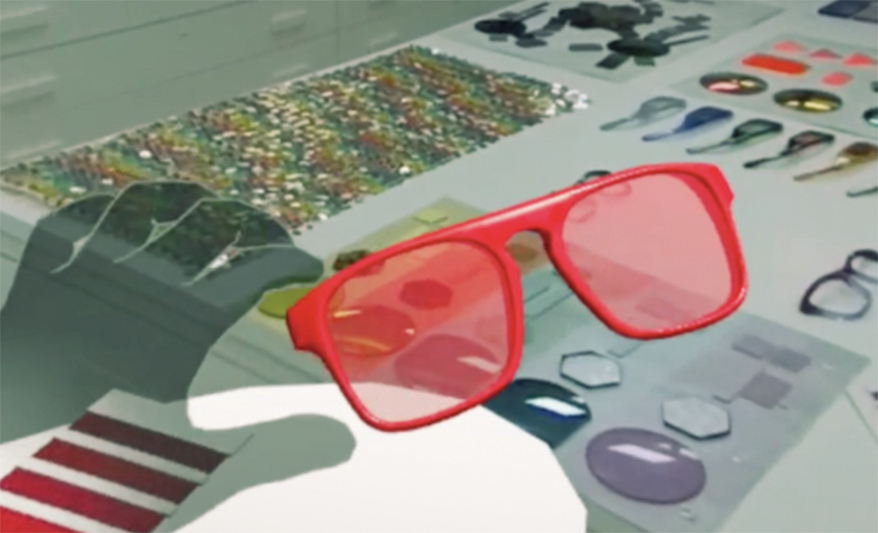
A snapshot of a 3D virtual recreation of Marcolin’s production facilities.
Curiosity…
and Fear
When we reached out to INVISION’s Brain Squad of eyecare business owners and managers to get their thoughts and questions about the metaverse, they expressed curiosity and excitement, but also bewilderment and even fear. “I’m sure VR and AR will be integrated into our field,” wrote one. “I can’t see how just yet and frankly, I don’t want to do so right now. I am still old school. I hope it waits until I retire.” But like it or not, the metaverse is already making inroads into the public imagination, and the infrastructure is taking shape. According to industry trends analyst Gartner, by 2026, 25% of people will spend at least one hour a day in the metaverse for work, shopping, education, and social and/or entertainment activities.
The eyewear and eyecare industries are already taking their place in this environment, so we think it’s time you at least get the lay of the land.
So far, much of what has already been developed in terms of metaverse presence exists at the industrial and B2B levels. Writing on the World Economic Forum’s 2023 Annual Meeting blog, Nokia chief strategist Nishant Batra wrote, “Many new factories exist just as much in the digital world as they do in the physical, allowing operators to visualize operations down to the smallest detail.” Italian eyewear maker Marcolin is already there, having created a 3D virtual “twin” of its Fortogna production facility so that it can be explored by trainee employees wearing VR headsets. But a consumer-facing metaverse is also emerging — if you have a virtual try-on option on your website, you’ve got a toe in it already. This is the interactive, virtual technology our Brain Squad respondents were most familiar with, though some pointed out that carrying unique frames from independent designers makes this harder to implement. “I know that virtual inventory and try-on is engaging for the patient,” says Lisa Smith of Precision Eyecare in Vancouver, WA, while expressing concern that, “I still have not found an easy way to incorporate that to my website because of the independent brands we carry.”
*BLOCKCHAIN is a technology that allows digital information to be stored simultaneously, and updated synchronously, across a distributed network. It’s a bit like the text in a Google Doc that’s being worked on by a team, all of whom are constantly synced. The analogy ends there though, because unlike Google Docs, blockchain enables networked computing in the absence of any central authority or platform (such as Google) controlling everything.
Before we go much further, this might be a good place to address exactly what we mean when we talk about eyewear in the metaverse. If you’re hazy on this, it’s not just you. “I have a hard time wrapping my brain around the metaverse,” says Travis LeFevre of Krystal Vision & LFVR Eyewear in Logan, UT. “In a virtual world why would virtual people need glasses?” These will be elaborated on individually later, but in the metaverse, people are virtually trying on and purchasing real frames; buying digital frames for avatars as part of digital wardrobes that can be “worn” across platforms; seeking help with fit and Rx issues arising from wearing their glasses under VR or AR glasses; and ordering prescription lenses for VR/AR goggles that support them.
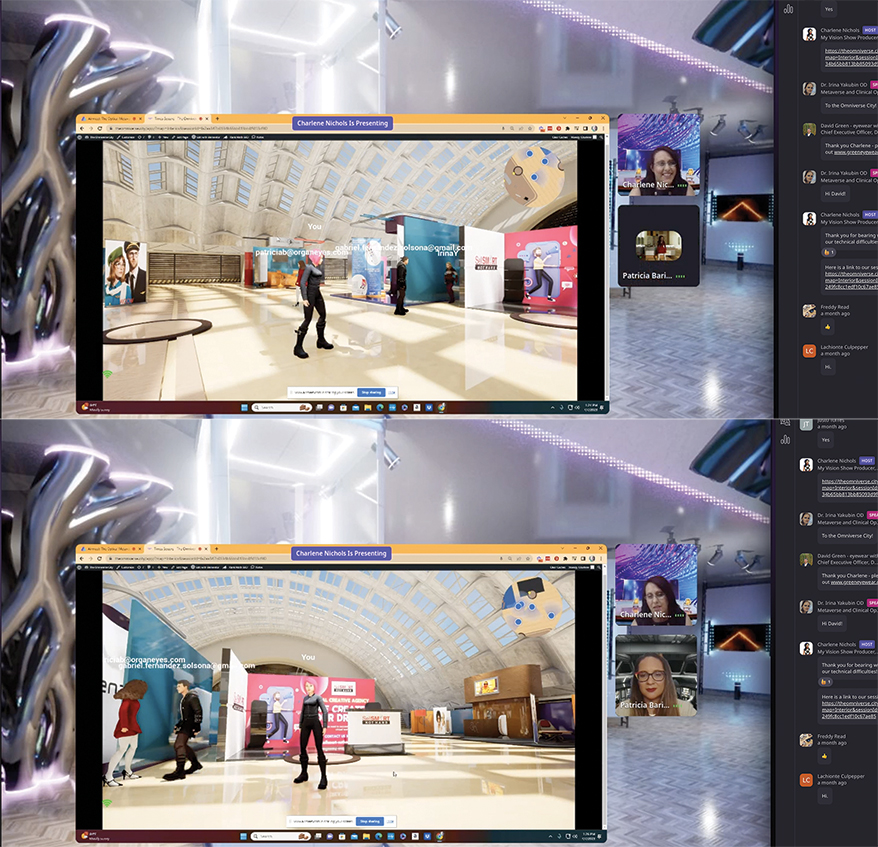
‘The Optical Metaverse’ founder Charlene Nichols conducts a guided tour of the platform’s immersive Exhibit Hall.
Meet Me in
the Metaverse…
One type of platform luring consumers is virtual shopping centers or marketplaces such as Sandbox, Decentraland and Somnium Space. Nicolas Arreste, co-founder of BEGOOD Creative Marketing Agency, which helps businesses, including eyecare practices, establish themselves in the digital space, believes the metaverse is a natural fit for eyecare and urges ECPs to explore it. He told INVISION, “We’ve seen many e-commerce brands open retail storefronts in the metaverse equipped with what you would find in a true, physical retail environment, including customer support personnel and the option to purchase products. Eyecare practices should use this as a guide to reach new eyewear customers. As technology transitions to Web3, a decentralized environment that will most likely enable better PHI protections, eyecare practices could benefit greatly from the metaverse by opening virtual practices.”
Bear in mind that at this point, not all metaverse experiences are totally immersive or necessitate VR goggles. As an entry point for eyewear businesses, Arreste suggests a 2D virtual platform — still fully digital and interactive, using avatars — like shopmetamarket.xyz. “Metaverse users will be able to try a practice’s eyewear virtually and order on the spot,” he says. “This can increase eyewear sales and overall brand awareness, which could lead to an increase in patient visits.”
Advertisement
One platform targeted directly at ECPs is The Optical Metaverse. Pitched by founder Charlene Nichols as an immersive virtual trade show, networking and educational space, the platform hosted the Optical Metaverse Fashion Show in July. Participants chose an avatar before entering the space and could then check out scheduled, streamed webinars on eyewear and eyecare related topics, head into dedicated booths to virtually try on eyewear and chat with representatives of participating eyewear brands such as David Green Eyewear, Kirk & Kirk and Kazoku Lunettes, wander around a central exhibition space and more. Participants also had the opportunity to approach and chat with each other. The overall impression was more of forward-looking pioneers feeling their way around a new world than of a bustling trade venue, but it certainly offered a glimpse of what the future may hold and seemed to have come a long way technologically since an early version INVISION checked out in 2022.
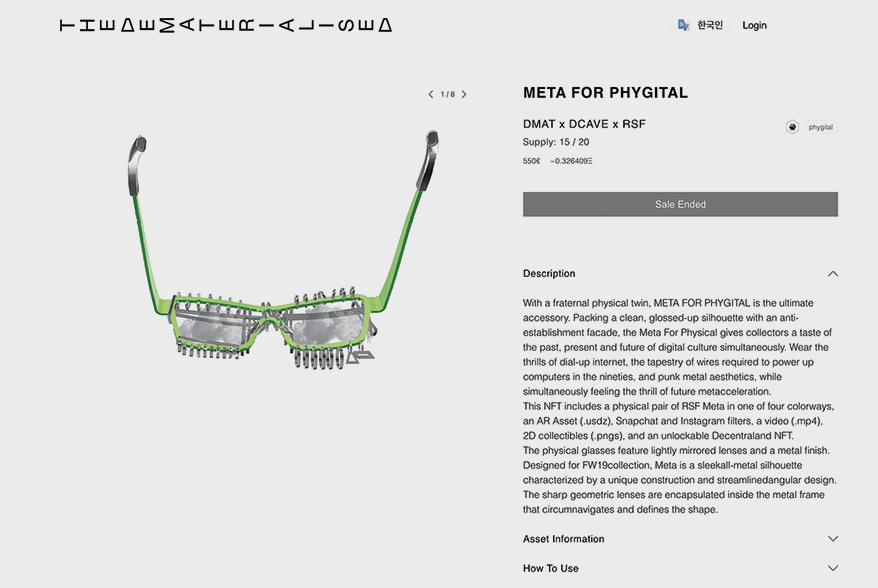
RSF’s Meta NFT virtual frame for avatars on the Decentraland platform has a real-world ‘twin’.
Virtual
Style
In the fashion metaverse, brands like Gucci are leading the way. Their Gucci Town, which can be entered using an avatar on the Roblox gaming platform and experienced with or without VR goggles, features virtual Gucci items that can be purchased for players’ avatars. The Decentraland platform hosted its first Metaverse Fashion Week last year, with brands like Dolce&Gabbana introducing “metaverse wearables” for avatars, which can be worn across platforms. (And yes, people will pay for such things — a digital version of Gucci’s Dionysus bag sold for over $4,000 on Roblox.) So the potential for eyewear brands should be obvious.
What’s different about frame purchases in the metaverse is that frames — both virtual and real — are sold as NFTs (see box), meaning ownership is established digitally, through a “token” on a blockchain. Searching for eyewear on platforms like Decentraland throws up a number of virtual frames of varying interest by NFT artists, but a few established brands like RSF have begun offering virtual lines for avatars. Woodys is offering real-world frames as NFTs on OpenSea, which accepts many cryptocurrencies. Digital art renderings (not wearable by people or avatars) of the frames can also be purchased.
*WEB3, envisioned as the next iteration of the internet, will (likely through blockchain) allow digital ownership and proof of identity — including, most importantly, of your own data. In Web2, Facebook, Google, Amazon and their ilk own and control it all because they own the platforms. The user autonomy afforded by Web3 platforms opens up a very different economy. Users can move the things they own and create from one platform to another. They can charge fees for data used and also invest and become stakeholders in the platform/space.
Another example of real-world NFT eyewear is the CryptoKing$ NFT line of sunglasses from Philipp Plein, whose European boutiques accept both regular and cryptocurrency payments for the limited series. Every frame comes in an exclusive box equipped with a video screen offering what it calls “a preview of the unique version of the NFT archived in the Blockchain.” It adds, “The exclusivity of the NFT will be guaranteed by a QR code found within the special box, which the user will simply need to scan with their smartphone.”
Gimmick or killer differentiation point? You decide, but there’s no denying that NFTs put a new spin on the idea of “limited edition.”
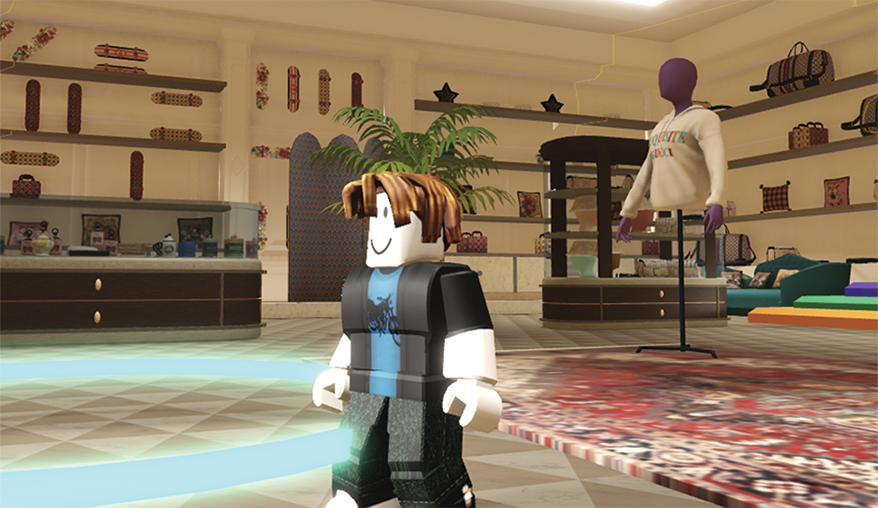
Gucci Town, a metaverse store selling virtual wearables on the Roblox platform.
Experience
Before You Buy
In the optical, VR and AR could be harnessed to create memorable, immersive experiences that demonstrate the power of new products to customers and patients. Expressing the mix of wonder and apprehension that many ECPs feel about the metaverse, Morgan DiMaggio of Taylor Eye Care in Carmi, IL, seemed to grasp this potential when she told us: “First of all. It’s terrifying! I can see how maybe it could be useful for demonstrating certain hobby specific lenses — i.e., certain colored polarization and mirror combos for certain hobbies. We try to keep up with all of the latest technology, but this is super intimidating.” At A Proper View in Winston-Salem, NC, practice manager Kelsey Bredice sees potential for VR tech “to help new PAL wearers understand how that lens design is going to look so they aren’t surprised when they try them.” Another use occurred to Dr. Mason Childers at Wiregrass Eyecare of Ozark in Ozark, AL: “A virtual headset or mirror with a database of all styles and colors would be incredible!”
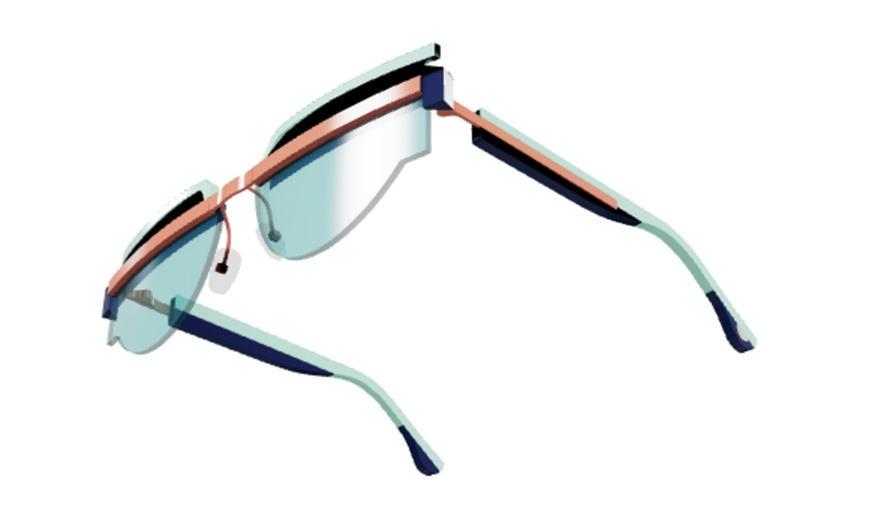
Digital rendering of a frame from the NEON-G line, Woodys’ first NFT collection designed for the metaverse.
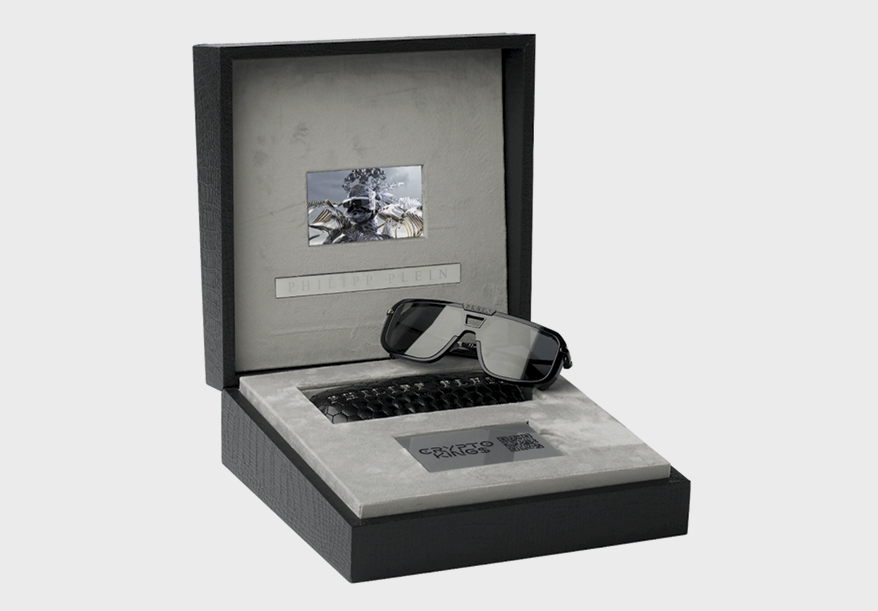
The CryptoKing$ NFT sunglasses from Philipp Plein.
Eye Docs in
Space Stations
In the medical sphere, the utility of VR and AR tech has long been apparent to optometry schools — SUNY College of Optometry’s Virtual Simulation Lab being a standout example. Another promising application of the metaverse is professional peer-to-peer communication. One organization that has already moved to tap this potential is the Digital Ophthalmic Society (DOS), which held its 2022 annual meeting entirely in a virtual reality environment designed to look like a space station. Participants (or their avatars, some of them in digital space suits) got around in helicopters, attending seminars including surgical videos presented in 3D. Participants could approach each other and smaller discussions were held in conference rooms.
A *Cryptocurrency is a medium for making online payments, with transactions recorded in online, encrypted public ledgers that use blockchain, so the data and records are stored and simultaneously updated in all locations across the distributed network. No need for a bank or central authority to hold and send the money, approve the transaction or take a cut of it. NOTE: If all this talk of cutting out the “central authority” — especially when it comes to money — strikes you as something of a doubleedged sword, you’re not alone. It’s been bothering the actual “central authority” a bit too. The SEC sees cryptocurrencies (with the exception of bitcoin) as unregulated speculative securities and began legal proceedings against crypto protocol Ripple, traded as XRP. In July, a court handed down a complicated ruling that Ripple interpreted as a victory for its argument that it is not a security. The SEC has appealed.
Separately, DOS co-founders Eric Rosenberg, DO, and John Kitchens, MD, in collaboration with some colleagues, organized the first-ever grand rounds in the metaverse in June last year.
According to veteran ophthalmic tech Lynn Lawrence CPOT, ABOC, founder of See the Light Consulting, VR and metaverse infrastructure promise to deliver improved methods of training and professional testing industry-wide. “Currently… it is fairly expensive to conduct any hands-on type of training,” he says, “but the new metaverse interactive platform will allow anyone to develop a program that is tailored to the specific needs of their organization.”
He also believes the metaverse will “revolutionize” all of the major certification companies. With AI and robotics having already entered the medical field, he said, “The metaverse is going to take the offices of those willing to invest further and faster than those moving down traditional learning and performance paths.”
Meta Testing
and Therapy
VR’s ability to track eye movements has made it particularly valuable in visual field testing, and this is one area a number of INVISION’s Brain Squad members have already ventured into. Eyes on Trade in Winston-Salem, NC, has introduced the Heru visual field device into their office, says practice manager Maggie Campbell. Heru’s “wearable platform” performs nine vision exams supported by five reimbursable CPT codes, with the patient guided through the experience by a virtual “onboard personality.” The manufacturer pitches the VR headset as improving practice efficiency and workflow by removing the need for a designated exam room. Their marketing contrasts images of patients wearing the headset — some sitting in comfy chairs in their own homes — with an array of “uncomfortable” testing machines in a doctor’s office. Whether or not this particular point of differentiation appeals to you, it’s clear that VR companies are intent on marketing it as a tool that takes the stress out of patients’ engagement with medical professionals.
*NFTs or Non-Fungible Tokens are unique digital assets stored on a blockchain. NFTs are unique because they cannot be exchanged for other tokens or assets on a one-to-one basis like cryptocurrencies. Instead, each NFT is unique and has its own value. (Oxford Dictionary defines fungible as “replaceable by another identical item.”) The tokens are used to represent ownership of a unique item or asset such as eyewear, digital art, music, videos, and other creative works. Most NFTs are digital but they can be physical assets. NFT marketplaces include OpenSea, Rarible, SuperRare and Nifty Gateway.
VirtualVision’s Virtual Eye comes with features such as cloud-based testing and 256-bit encryption to ensure HIPAA compliance. The possibility that patients could do vision therapy and sports vision at home through VR devices is causing excitement at EyeShop Optical Center in Lewis Center, OH, says owner Dr. Cynthia Sayers. So is the prospect of “implementing these devices for certain testing, and decreasing the amount of space that our current instruments take up,” she says. “We could efficiently see more patients if multiple tests could be done with one small device.” The crew at Atlantic Cape Eyecare in Wildwood, NJ, seem to be on board: “We’re just scratching the surface here,” says Dr. Richard Frankel. “Every piece of exam equipment has the potential to be positively impacted. Future exams will be total immersive.”
Getting Your Head
Around Headsets
VR and AR also present ECPs with another market: While some VR goggles are designed to fit over the user’s glasses, many people find this leads to scratching or fogging and will go looking for professional help — whether it’s for non-scratch or anti-fogging lenses, smaller frames, or “spacers” designed to keep the goggles and glasses apart, or even for a new pair with an adjusted Rx because they’re having trouble seeing what’s displayed. Some headsets can accommodate Rx inserts — Apple has partnered with Zeiss for its Vision Pro headset and Meta offers Virtuclear lenses, and there is an online market for cheaper inserts — but judging by the conversation on Opticians on Facebook, there is a lot of adjusting needed to make the experience satisfying for glasses wearers. Getting an optician on your team up to speed on the particular needs of gamers and metaverse early adopters, and spreading the word in those communities, could bring some business your way.
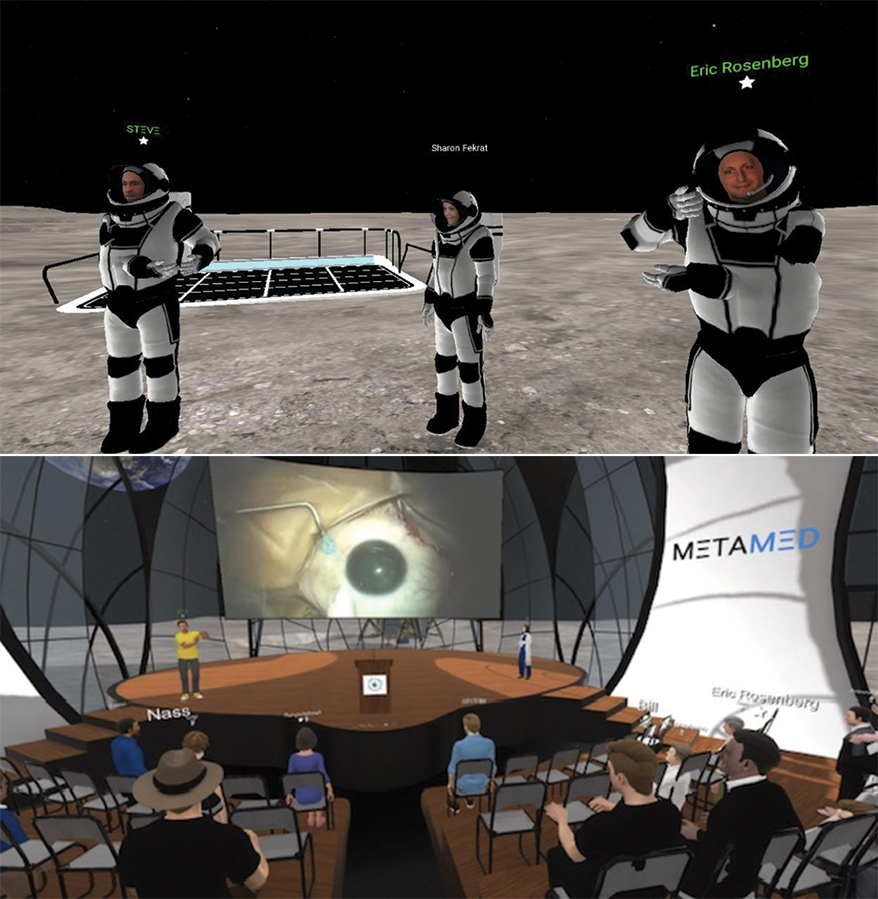
Speakers and attendees take part in the Digital Ophthalmic Society’s annual meeting last year, held entirely in the metaverse.
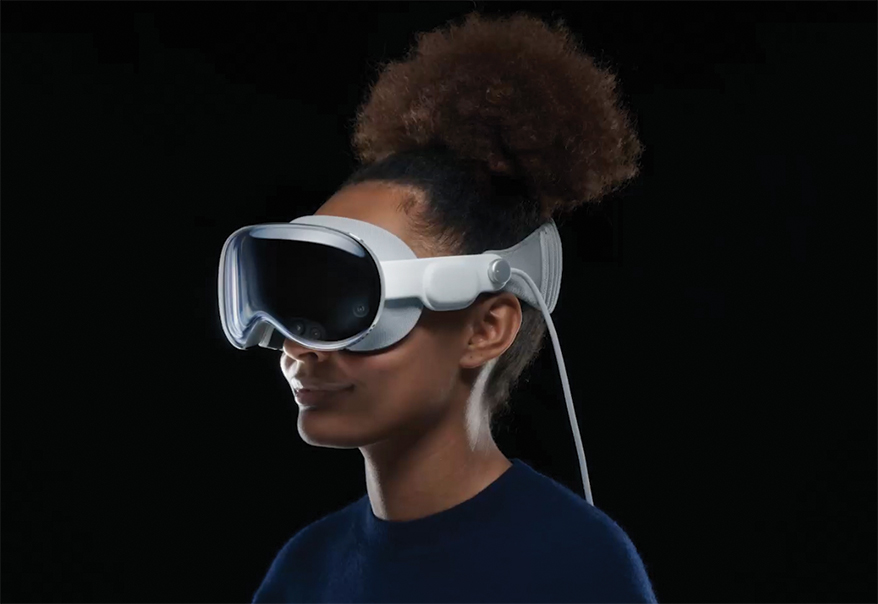
Apple’s Vision Pro, a mixed VR/AR headset, returned metaverse technology to the headlines when it was unveiled in June, but at a cost of $3,499 when released next year it will be out of the reach of many.
Back Office
Revolution
nsurprisingly, insurance companies are already investing in blockchain due to its ability to help them more efficiently and securely maintain records, execute transactions and interact with healthcare providers and patients. It could also help them understand and price risks better, leading to faster claims processing and lower costs for consumers. According to PricewaterhouseCoopers, in 2017, only 8% of insurers had plans to invest in blockchain, but in their most recent study, 81% were familiar with it and anticipated its widespread adoption in the industry. This is just one of the disruptions eyecare office managers can expect. Says Lawrence: “I truly feel that the metaverse will have a significant impact on staff hiring, on-boarding, programmed training, customer service and customer service training, individual and team development, and performance monitoring.”
Whereas virtual reality (VR) is a completely immersive, simulated 3D world entered using goggles in which the user looks at a screen, augmented reality (AR) technology superimposes computer-generated 3D images on a user’s view of the real world, creating a composite experience using special glasses. Smart glasses, meanwhile, are wearable products that feed 2D info into your field of view, sometimes with an audio component and AI functions. Stories by Ray-Ban — frames that allow wearers to capture video, listen to music and podcasts, and take calls — along with the Alexa-enabled Amazon Echo, and IrisVision, a smartphone-tethered frame for low-vision patients, are examples of the latter.
“We live in a time of amazing technological change,” John Marvin, president of Texas State Optical, a network of independent optometrists, wrote in this magazine nearly a decade ago in a column that aimed to convince his peers of the need to put their mistrust aside and fully embrace Web2 marketing tools such as Facebook. “Do you want to be someone who makes things happen, or one who wonders what happened? It’s time to embrace technology as an opportunity to provide better care and greater patient satisfaction.” On the cusp of a new technological era, his advice rings truer than ever. Changes are afoot, if for no other reason, says Lawrence, than “The folks dealing with the metaverse are extremely motivated to succeed, therefore there is a high probability they will.”
Of course we need to be wary of fads and frauds, and technology should always be deployed in service of, never as a substitute for, the very best customer service and patient care. That, after all, is what will continue to set you apart, regardless of how the technological backdrop of our lives changes. We’ll give the last word on the subject to Colorado-based “optical nomad” Heather Harrington: “The potential of the retail metaverse for the optical industry is immense. By leveraging VR and AR technology, opticians can create highly engaging and personalized experiences for customers and patients, which is only becoming more beneficial to the next generations we are dispensing to,” she told INVISION. “Not only will it help our optician-to-patient experience, but it will also help education and training within the optical realm and I am here for it! I definitely plan to be a part of everything optical in the metaverse in all realms.”
ONLINE EXTRA: INTERVIEW 1
The Metaverse: A Frame Designer’s View
Selin Olmsted is the founder of the Selin Olmsted Design Studio in NYC, which provides independent design and product development services for a range of leading US and international eyewear brands. In the following interview, we asked her for her thoughts on what the metaverse might have in store for eyewear designers and manufacturers.
INVISION: Have you had any involvement or interaction with eyewear and the metaverse?
SELIN OLMSTED: Our team has not had any direct involvement or interactions with eyewear and the metaverse yet. However, we have partnered with one of the biggest technology companies out there and have collaborated with their corresponding teams on some of their projects. More updates to follow soon.
What do you think are the implications of the metaverse for frame designers and eyewear brands?
At this moment there are three different categories:
1.) Hardware to enter the metaverse: This is where a designer/brand creates an AR/MR/VR eyewear unit for the wearer to enter the metaverse. We see most of the projects out there in the market are currently focused on this category. Integrating the eyewear seamlessly into their everyday life/work life is crucial here. Tech is not there yet to support the ideal fit, comfort and aesthetic concerns. However, I do see it improving quickly.
2.) Eyewear available in both ‘verses’: This is when a designer/brand creates eyewear that is both available and can be worn in the metaverse and physical life.
3.) Metaverse eyewear: This is when a designer/brand creates eyewear that would be solely worn virtually. I can imagine some pretty wild design happening. Like glasses made out of liquid metal or neon. Also, what if your avatar has three eyes that are vertical? Yeah I think we will see a lot of amazing ideas. Design details, shapes and color combinations we would think are too risky for commercial success in physical life wouldn’t be a topic of concern in the metaverse. The decisions we make during the design process would be completely different.
Advertisement
Should (or do?) virtual frame designers have experience designing physical frames?
Yes and no at the same time. Let’s unpack that.
Yes in the sense that I can see high-profile luxury brands wanting to avoid looking gimmicky and connect better with the customer when they are designed by experienced eyewear designers. Then from that solid foundation, the designer can take the eyewear to the next level of creativity.
That said, who knows what the metaverse’s culture will think on ‘What is a successful design’? Eyewear designers who want to focus on the metaverse would probably need to worry less about physical constraints. The real focus probably is more of a dive into the motivations of virtual customers to make something impactful for them. I can also see a bit of potential resistance to move beyond the existing knowledge. But probably this will just be a short adjustment period before we go above and beyond in this new realm. For certain we will be challenged in ways we can’t imagine right now.
Do you have any opinions on virtual frames that you have seen?
The NEON-G from Woodys Eyewear was actually the first time I saw this. They created an eyewear style that can could be worn both, by the wearer in physical life and by their avatar in the metaverse. It was a groundbreaking idea to launch a “phygital” product. But at the moment I think there are still a lot of questions around whether it’s financially important to do this. It’s an intriguing challenge for brands to figure out.
Not to mention that virtual try-ons have exploded sales in the eyewear e-commerce market. There are so many upsides to this around travel time and carbon footprint, I can only see this technology scaling up as fast as possible. I can see a day where all brands/stores (not just eyewear) will have a virtual experience for your realistic avatar to try on all the different products they offer. If you like something, it will be shipped to your house that same day. I think this will happen faster than anyone expects.
I am especially fond of the idea where we eventually merge the AR and the VR worlds together. I imagine a tech that will help remove the guessing game for the eyewear shoppers. For example, an eyewear enthusiast customer who is physically in Dubai, picking a unique style at an eyewear retailer in the USA. What if this customer’s 3D face photo or real-life-like 3D animation tries the eyewear, making sure the fit and the frame shape are right? Once realistic color and transparency are added impeccably to the 3D rendered eyewear’s material and lenses, there is no reason not to purchase the product…especially if the retailer offers international online fulfillment and shipment.
There are also non-consumer-facing implications, of course. For example, designers being able to collaborate in a VR or online 3-D environment, and discuss plans with brand executives. Marcolin offers an immersive 3D tour of their design facilities. Do you see any potential in this area?
I do. If I would freely brainstorm about the possibilities, I would list some of the B2B opportunities as:
- See machinery/tools being used by the craftsmen: An eyewear/material manufacturer offering an immersive 3D tour of their facilities to prospective clients and showing their capabilities, machinery, their innovative process how they approach prototyping and production.
- Instantaneous collaboration: Eyewear designers in different geographies can collaborate on various projects. Or share their knowledge and expertise with the studying, new generation designer candidates via an online 3D environment.
- Less sampling to be more environmentally friendly: An eyewear brand’s internal teams can review the potential color explorations for the newly designed eyewear styles for a future season in a VR or online 3D environment before committing to color samples. This will allow less sampling; more cost-efficient and environmentally friendly.
- More conscious buying: An eyewear brand can introduce a preview of their new launching collection in a VR or online 3D environment to its key accounts to get feedback for the initial buys.
- A streamlined eyewear fair experience: Attendees of international eyewear fairs can have some of their meetings or review new season eyewear in a VR or online 3D environment, before the physical fair. Then decide which companies to see in-person in the physical fair as time is limited. This will increase the productivity tremendously and allow us attendees make more beneficial and meaningful connections during the actual fair.
INTERVIEW 2
The Metaverse: A Leading Eye Doctor and Educator’s View
To get a sense of how VR, AR and other metaverse technologies are affecting optometric education as well as state-of-the-art eyecare, INVISION spoke to Dr. Matthew Bovenzi, Chief of Advanced Care at SUNY’s University Eye Center in New York and a former head of SUNY Optometry’s Virtual Reality Simulation Lab. (The lab is now run by Dr. Rahim Bahoo.) We asked Dr. Bovenzi a number of questions about what eye doctors should know about the metaverse, examples of how the metaverse and related technologies are being used by eye doctors, the connection between telemedicine and the metaverse, the future of the patient-doctor relationship, and what kind of equipment, technology and additional training eye doctors should be looking at. We thought his comments were interesting enough to run in full.
DR. MATTHEW BOVENZI: Our Virtual Reality lab is not for providing medical care to patients, but rather for students to gain experience in various skills (direct ophthalmoscopy, indirect ophthalmoscopy, slit lamp examination—all very important skills in general optometry and ophthalmology). This advanced equipment helps students to train in a virtual environment and get exposed to examining eyes and conditions for a long amount of time, without the downside of finding a friend or family member to dilate and practice on.
If we take a liberal definition of the “metaverse” to include the use of VR/AR tech in general, then that’s one way it’s going to benefit healthcare/eyecare—in the training of future eye doctors. Applications are wide-ranging, from procedural simulators like the ones we have at SUNY, to 3-D, immersive anatomy instruction, and even ophthalmic and medical imaging.
As far as that stereotypical “metaverse” that most who have heard the term are familiar with, where a person dons a headset and visits “virtual” people, places, and events…currently this is a new frontier, but it doesn’t take much to imagine what this frontier could look like. The COVID pandemic brought with it a sea change in the way we view telehealth. Previously, it was seen as fairly niche, or as a way for a doctor who lives hundreds of miles away to provide a second opinion or consult with a patient. But now, telehealth can be a real convenience even for routine visits.
If a patient doesn’t have to interrupt their busy workday to visit their eye doctor to address a simple problem, then there’s a market for this kind of care—and there are plenty of patients who would feel that way.
Currently, this involves logging into a computer on a video/telehealth platform, and discussing your case with the doctor on the other end. But what if, in the future, devices exist inside headsets that actually take pictures of the anterior or posterior segments of the eyes, and all the patient had to do was don their “metaverse” headset and a full eye exam could be conducted? Headsets with all sorts of sensors (including advanced eye tracking) are already undergoing research and production by companies like Google and Apple. Although none of this is currently geared towards healthcare, if they can track eye movements, why couldn’t they also then measure pupils? Or a patient’s phoria? Or more?
Advertisement
There are multiple companies coming out with Visual Field tests that involve the use of VR headsets; it’s only a matter of time before even more innovation hits the market. Patients can already check their IOP at home using devices like the iCare HOME, and there are groups researching the use of contact lenses to monitor ocular data, including IOP.
I do think that we are fortunate in optometry to have a very “social” profession. We see our patients annually; we get to know them. I don’t think we’ll ever lose that—that is to say, I don’t think the profession will evolve (or devolve) to the point where a “virtual patient” sees a “virtual doctor” and you never actually have a conversation with them in life, but rather with their metaverse avatars. The doctor-patient relationship—and the trust it is built on—is too important to lose that. So rather, I think the advances of the “metaverse” will come with respect to telehealth and live/synchronous or asynchronous testing, with doctors analyzing the data that come from these new innovations.